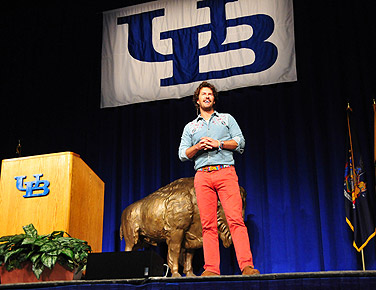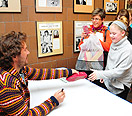News
Mycoskie finds profit, meaning in TOMS

Blake Mycoskie related to a UB audience the story of his company, TOMS Shoes, which has donated more than 2 million pairs of shoes to children in need throughout the world. Photo: STEVE MORSE
-
 Print
Print -
 Comments
Comments
-
Blake Mycoskie signs one of his TOMS shoes for a fan after the lecture. Click on the image to see a larger version. Photo: STEVE MORSE
Casually but colorfully attired, Blake Mycoskie Thursday night moved listeners at UB with his account of families whose lives have been altered because of the simple ability to don a new pair of shoes.
In some cases, Mycoskie told a youthful audience in Alumni Arena during his Distinguished Speakers Series lecture, these may be the first new pair of shoes a child has owned or wasn’t obliged to share with siblings. Indeed, the lack of what is a staple for most people in the U.S. can prevent a child from attending school or may bring about otherwise preventable diseases.
Mycoskie is the 36-year-old founder of TOMS Shoes, the altruistically minded company that gives away a pair of shoes for each one it sells. He is also author of this year’s UB Reads selection, “Start Something that Matters,” and many young audience members queued up for a signed copy of the book following the lecture. TOMS has donated more than 2 million pairs of shoes to children in need throughout the world, and the book offers Mycoskie’s stories, ideas and tips for finding both profit and meaning in one’s work.
Mycoskie said his journey to TOMS began about seven years ago when he was running an online drivers’ education company, one of four businesses he ran before starting TOMS. At this point, he was utterly exhausted from working 90-hour weeks preparing for the launch of the company’s online software program.
“I told my partners I really needed to take some time off for a month and completely unplug, and thankfully they allowed me to do that,” Mycoskie said. His choice of Argentina for the trip led to the founding of TOMS, but “a back story” was part of the reason why, he explained.
Ten years ago, he and his sister, Paige, competed on the CBS series “The Amazing Race,” losing out on the million-dollar prize by an exasperating four minutes. He had visited Argentina during the race, but now wished to more fully explore the country. One day, while drinking red wine in a café, he heard a group of English-speaking women discussing their drive to collect slightly used shoes from wealthy families in Buenos Aires and then distribute them to children who desperately needed them.
Intrigued, Mycoskie wanted to know more and so volunteered to help them distribute the shoes in a few days. “We got there and it was like nothing I’ve ever experienced in my life,” he said. “There were kids running out of every nook and cranny of this dilapidated town. The parents were so excited. The smiles on these kids’ faces, the embraces they gave you after you fit them with a pair of shoes. It was amazing, it was joyful and it was exciting. Those three hours—I can still close my eyes and remember every minute of them. I couldn’t leave not wanting to do more.”
Elation turned to a sober reassessment, however. Alejo Nitti, the polo teacher who became Mycoskie’s Argentine partner, reminded him that the children would quickly outgrow those shoes. Mycoskie began considering how he could create a sustainable venture that would allow the children to have shoes as they grew.
“I started thinking, why do we always go to charity to address the world’s needs, specifically, when it comes to poverty? Why not go to business with shoes adapted from traditional alpargatas and using a simple formula: You buy a pair, we give a pair” he wondered. Mycoskie informed his software-firm partners in Los Angeles that he had to stay in Argentina a couple more weeks “to see if we can make some of these shoes.” He and Nitti then made the first 250 pairs of what would become TOMS.
Yet, Mycoskie needed to figure out a way to manufacture the shoes longer term. Moreover, he had no experience in retail sales or footwear. Knowing how much time and attention “every woman in my life” spent on shoes, he showed TOMS shoes at a dinner party. His female guests liked the shoes, but became really excited after Mycoskie explained the fledgling company’s purpose.
His operation was small—equipped with a website and operating out of his LA apartment—but word was getting out, almost too effectively. When Los Angeles Times fashion writer Booth Moore featured the shoes in her column, TOMS sold 2,200 pairs on its website before 2 p.m. that day. “But I only had 144 pair in my apartment!” he said.
Email orders were coming in such volume that his Blackberry was “vibrating uncontrollably.” At this point, he began to advertise on Craigslist for nonpaid interns to work the summer in exchange for a pair of shoes, while he returned to Argentina. “It was one of the most magical moments in TOMS; we got all these small shoemakers around the city to come together and to start making these in volume. In three weeks, we were making 800-900 pairs a week.”
But the business success wasn’t what changed his life, Mycoskie said. Rather, those moments came seeing his mother putting shoes on a child and first hand-washing his scarred feet. Or when he witnessed a woman crying after her children had been fitted with shoes. Asking Nitti to find out what was wrong, Mycoskie learned that her tears were those of joy and saw that Nitti was crying, too.
“She was trying to tell me that these were her three boys. And for the past year they had been sharing a single pair of shoes, an old leather Oxford pair of men’s shoes. It was way too big for any of the boys and it was cutting their feet,” he said. The mother explained that her oldest son would go to school on Monday, return home, give the shoes to his brother and wait until Thursday when the shoes were again rotated so he could go back to school.
Today, Mycoskie said, he’s trying to bring TOMS to a new level, helping fellow entrepreneurs and the public at large to realize that giving doesn’t just feel good, “it is good for business.” The company is performing a similar service with TOMS Eyewear, helping to give sight for each pair of glasses or eyewear sold.


Reader Comments